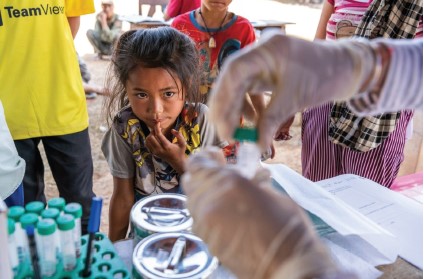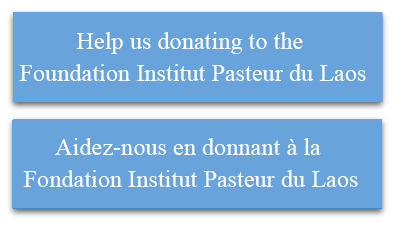Factors associated with hepatitis B vaccination in the Lao People’s Democratic Republic: findings from the Multiple Indicator Cluster Surveys in 2011/12 and 2017
 Collaborations.
Collaborations.
Luxembourg Institute of Health Vrije Universiteit Amsterdam.
Funding.
Ministry of Foreign and European Affairs, Luxembourg.
Luxembourg Institute of Health, Luxembourg.
Objectives.
Investigation of risk factors and predictors for vaccination with hepatitis B vaccines.
Background.
Hepatitis B vaccination is part of the pentavalent diphtheria-tetanus-pertussis-hepatitis B-Haemophilus influenzae type b vaccine (DTPw-HepB-Hib). Vaccination coverage rates were reported to be at 75% for the 3rd dose of DTPw-HepB-Hib and 64% for the birth dose in 2021, which is considerably lower than the aim of ≥90%. Analyzing coverage data to identify potential barriers to receiving childhood vaccinations may help increase vaccination coverage.
The Multiple Indicator Cluster Surveys (MICS) were designed by the United Nations Children’s Fund (UNICEF) to collect internationally comparable household survey data. In the Lao PDR, surveys were carried out in 1996, 2000, 2006, 2011-12 and 2017. All datasets, but the earliest data from the survey in 1996, are freely accessible.
Methodology.
We used the MICS dataset of children under 5 years of age from the years 2011-12 and 2017 to explore what socio-economic factors are associated with receiving the hepatitis B birth dose or hepatitis B antigen-containing vaccines. We used both logistic regression analyses and hierarchical modeling to identify important predictors for receiving hepatitis B vaccinations in the Lao PDR.
Results and discussion.
In 2011-12, around 60% of the children received the hepatitis B birth dose and around 60% received three doses of the hepatitis B antigen-containing combination vaccine according to either vaccination documents or the caretaker’s recall. There was an increase to just under 70% in 2017. In both surveys, vaccination coverage rates varied extensively between provinces.
Children from Hmong-Mien households were considerably less likely to receive the hepatitis B birth dose and combination vaccinations in both surveys. Between the two survey time points, the proportions of home births decreased considerably. We found that the place of delivery is still an important predictor for hepatitis B birth dose vaccination. Children whose mothers stated that they delivered their last live birth in the past two years at a hospital were more likely to be vaccinated with the hepatitis B birth dose in both surveys as compared to children of mothers who delivered at home. Children from wealthier households were also more likely to be vaccinated. Although vaccination services are free of charge for children, it may not be possible for some parents to take time off from work or have the means for transportation. In both surveys, children whose mothers received some formal education as compared to none, were more likely to have been vaccinated.
Conclusion & perspectives.
This study presents the first utilization of MICS data from Lao PDR to analyze factors associated with vaccination coverage. We found important predictors for childhood hepatitis B vaccination: children from Hmong-Mien households, from households with poor socio-economic status, with less educated mothers and with mothers who did not deliver at a hospital or were not accompanied during their delivery by a medical professional or who did not receive sufficient ANC are particularly vulnerable for missed vaccinations.
Taken together, our results indicate the need for a detailed assessment of healthcare access for ethnic minority groups. We suggest investing in the training of medical staff at the health center level to improve mother and child health.
Publications in 2023.
Black, A. P., Wallace, J., Binka, M., & Butt, Z. A. (2023). The challenges of viral hepatitis elimination: a global response to a global problem. In BMC Public Health (Vol. 23, Issue 1). BioMed Central Ltd. https://doi.org/10.1186/ s12889-023-15960-w
Vantava, S., Hefele, L., Virachith, S., Vannachone, S., Khounvisith, V., Nouanthong, P., Hübschen, J. M., Sayasone, S., & Black, A. P. (2023). Low seroprotection against diphtheria and tetanus in Lao adolescents. Tropical Medicine and International Health, 28(6), 501– 506. https://doi.org/10.1111/tmi.13882
Congress.
Oral presentations.
Pint of Science Vientiane, Lao PDR 20-21th May 2023.
Vilaysone Khounvisith: “WASH away Diseases”.
Congress attendance.
2nd Annual Vaccination Acceptance Research Network conference, Bangkok, Thailand 13-15th June, 2023.
Antony Black, Vilaysone Khounvisith, Siriphone Virachith.
Teaching activities.
Immunology course for IPL military trainees, April 2023 and October 2023 (2 hours); Siriphone Virachith Biosafety and Biosecurity, 07-18th October 2023, Siriphone Virachith.
Training activities.
Trainings given by the team.
Co-supervision of Sypaseuth Duangmixay, for his Master’s research thesis at the Lao Tropical and Public Health Institute: “Latent tuberculosis infection among high-risk Healthcare workers at Central hospitals in Vientiane Capital, Lao People’s Democratic Republic, Using QuantiFERON-TB gold plus.”; Antony Black and Siriphone Virachith.
Biorisk management and assessment: 22nd May -2nd June 2023, Siriphone Virachith.
Trainings undertaken by the team.
Viral Genome and Metagenomic Sequencing workshop, Singapore, 20-27th October 2023; Vilaysone Khounvisith.
Training at Luxembourg Institute of Health – HDV PCR, sequencing, sequence analysis, phylogenetic analysis and genotyping, November-December, 2023; Siriphone Virachith.






